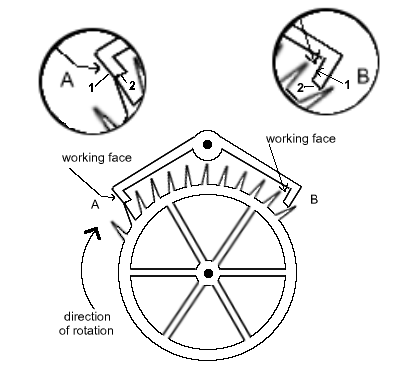Clock Repair Archive – – Dead Beat escapement ( Graham escapement ):
The gear train applies power to turn the escape wheel in the direction indicated. At A and B, the working face consists of the areas marked 1 and 2. When power is applied to the escape wheel through the gear train causing the escape wheel to rotate in the direction indicated, the verge is given a gentle push as the escape wheel tooth slides on area 2, after it locks on area 1. The amount of “lock” varies from clock to clock. The escape wheel should not rotate during the lock portion of the operation. The power transfer occurs during the slide operation. The escape wheel picture is for illustration only. Escape wheels like this always have gear teeth all the way around the gear!
This dead beat escapement, also known as the graham escapement, is characterized by its action of lock and slide as it operates. There is no recoil of the escape wheel as the verge moves back and forth. When properly adjusted the escape wheel moves in one direction only. This type of system can be recognized by looking at the verge. Pay particular attention to the working faces of the verge, there will be a flat edge where the escape wheel tooth hits upon releasing from the opposite side and a sharp edge that the tooth drops off from the flat part and an angled surface that the tooth slides along as it gives the pendulum an extra push until it lets go and the whole thing starts again on the other side. This type of system is very accurate when properly adjusted, because the verge has significant control over how much power is delivered to the pendulum. If however there is too much lock or not enough lock the accuracy and dependability will be questionable at best. The depth setting is not the same for all clocks although the principle is the same. Generally speaking weight drive clocks with heavy pendulums are more sensitive and require somewhat shallow depth settings keeping in mind not to completely eliminate the lock segment of the operation. The lock is the amount of distance past the edge between surface 1 and 2 that the escape wheel tooth first makes contact on each tick. The following is a list of some of the sensitive clocks:
- Seth Thomas #2 regulators : Slight lock– .005 inch
- Most vienna regulators : Very slight lock– .0025 inch
- most french clocks Slight lock– .003 inch
- jewelers regulators (large wall clocks and floor clocks with mercury filled pendulums): Extremely slight lock– .002 inch.
The above information is intended as a guide. In each one of those groups there have been hundreds of thousands of clocks made over the years with hundreds of variations on each style. These names are general catagories of types of clocks. Even the Seth Thomas #2 regulators have some variations. On all of the above clocks watch the motion of the pendulum. Vienna regulators often do not have a large arc ( swing of the pendulum ). One inch is not unusual. The Seth Thomas #2 regulator usually has a large arc ( 3 inches is not uncommon ) and a very heavy pendulum.
